Lytham Windmill in the 20th Century
|
|
1900s
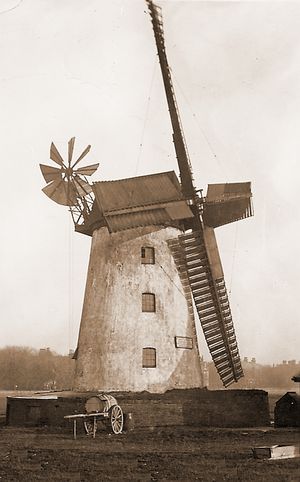
|
1907
LYTHAM'S WINDMILL
SOME INTERESTING MEMENTOES.
A suggestion has recently been made that
windmills which have served a Parish for years should be acquired
by the local authority and kept in repair as monuments of the past.
The idea is a good one. Fortunately, the mill which is such a
feature the promenade is in good state of repair, and there no
likelihood of it being allowed to go to rack and ruin whilst it
earns its keep as well as it does.
In windy weather the sails provide more power
than is needed, but, like many modern windmills it is fitted with a
gas engine, so that when the sails languish for a natural puff,
artificial puff is provided, and the jolly miller’s wheels go round
regularly as though it were a modern flour mill.
Some of the Visitors.
For fifteen years Mr. William Swann has worked
the mill, and never had the slightest trouble with hands for very
good reason. There are only two of the latter in the place,
and they both belong to Mr. Swann. In winter it is rather lonely,
but like Paul, the miller has learnt to be content, and has
quite affection for the place.
In summer the visitors would prevent him from
being dull if were so inclined, though his visitors have been
considerably fewer this year on account the bad weather. There must
be hundreds of address cards fastened up the wall, from all
manner of people, including the High Sheriff of Belfast (Dr.
O’Neill); the daughters of Col. Foster, M.P., of Hornby Castle;
Gertie Sinclair, of Drury Lane; Mr. Charles Bertram, the famous
conjuror; General French’s Staff Officer during the time of the
Boer War; Mr. Louis Klein, a neutral Boer who came to England when
the war broke out, etc.
He has had visitors from all over the United
Kingdom; America, New Zealand, France, Australia, Africa, and the
West Indies. In 1900 a visitor from Buenos Aires left his card. The
following year a visitor noticed the latter with considerable
surprise and informing the miller that the man was his neighbour,
pinned up his alongside. One person has written on his card “God
bless the miller.” Another inscription is Gone but not
forgotten.”
Rochdale Lady’s Rhyme
A Rochdale young woman left the following verse. It is only a
modest effort but the rhythm will compare most favourably with some
the Limericks one comes across now and then:
I can certainly direct you at early morn
To the jolliest miller that ever ground corn;
In the windmill at Lytham on the prom by the sea
The millers as happy as happy can be.
Preston Herald - Saturday
21 September 1907
|
|
|
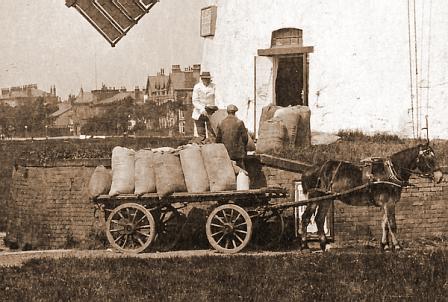
William Swann was the miller at Lytham
Windmill between 1895 and 1919. In his spare time he built models of the
windmill; one can be seen on the photograph below.
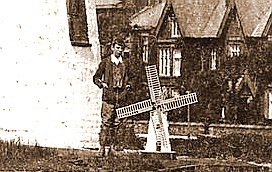
|
|
1914-18
War
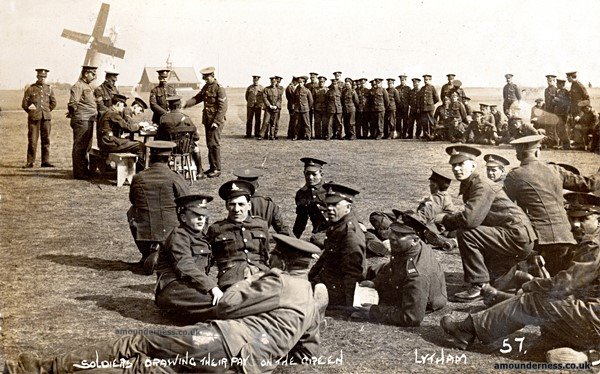
Soldiers on Lytham Green
c1915 with the windmill in the background. Thousands of soldiers
from Lancashire Regiments were billeted in Lytham & St Annes during 1915 &
1916. Many drilled in the shadow of the windmill on Lytham Green
and dug trenches on the beach in readiness for The
Front.
Windmill
Land
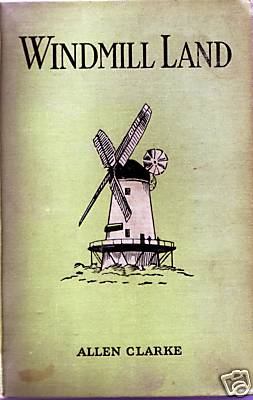
Windmills were fast disappearing from the English landscape and
in 1916 Bolton-born Allen Clarke published “Windmill
Land" which covered most of the Fylde windmills, past and present.
"The appeal of the book is in its loving descriptions of the Fylde and its
windmills, its people and its legends and traditions." It was
reprinted in 1986 and is still a popular read.
|
Mr. Allen Clarke’s “Windmill Land" (Dent and
Sons, 3s 6d net) is rather nearer than its greater namesake, and
lies only a few hours’ journey from Liverpool, in that part of
Lancashire commonly known as the Fylde.
Even here windmills are no longer the familiar
objects that they were twenty years ago, and many of Mr. Clarke’s
photographs perpetuate the memory of now vanished mills. He is a
discursive writer, who effectively destroys the “guide-book”
atmosphere by the insertion of much autobiographical matter, and
frequent excursions into verse.
One would imagine that Mr. Clarke bad quite
exhausted in this volume his very considerable windmill lore, but
it appears that has second volume is in the process of preparation.
To those eager to obtain knowledge of the Fylde, and attracted by
its local history, the book will prove an extremely interesting
one.
Liverpool Daily Post -
Wednesday 14 March 1917
|
"Storm
Brewing"
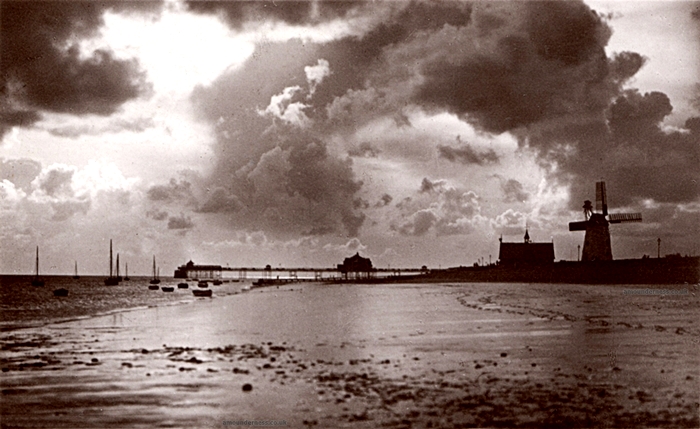
Photo from about 1908 of Lytham beach, windmill &
pier titled "Storm Brewing".
|
|
1919
At the height of storm force gales on the night of the
1st & 2nd of January 1919 the sails of the windmill span violently out of
control causing a devastating fire to start within the building. By the
following morning it was completely gutted. The sails, which
had first turned during the Napoleonic War, fell and smashed onto Lytham
Green, less than two months after the end of the Great War.
|
OLD LANDMARK GONE.
Lytham Windmill Destroyed by Fire.
The gale at Lytham caused the destruction of the
picturesque old windmill which has been the most prominent feature
of Lytham's promenade for well over a century.
The sails wriggled about and the friction of the
brake set fire to the dry-as-tinder oak and pitch-pine beams. Over
a hundred sacks of oats were destroyed, along with all the
machinery, and the old mill was burnt out completely. The flames
were seen from all sides of the estuary.
Manchester Evening News -
Thursday 02 January 1919
|
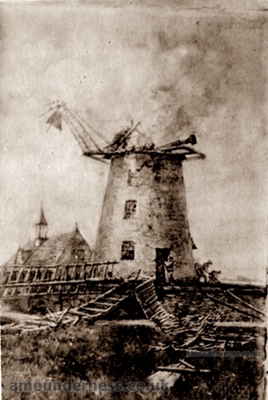
Painting by Lytham artist, Walter Eastwood, of the smouldering windmill on the morning of 2 January
1919.
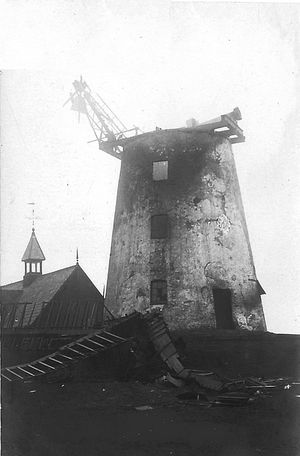
|
|
1920s

After the fire the windmill became a derelict eyesore and
remained a forlorn sight blighting Lytham seafront for several years. The structure
was owned by the Squire of Lytham but windmills were obsolete and there was no
financial gain in rebuilding. The outlook was bleak and demolition seemed
inevitable.
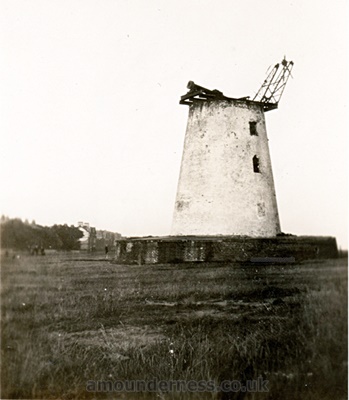
Lytham Windmill c1920.
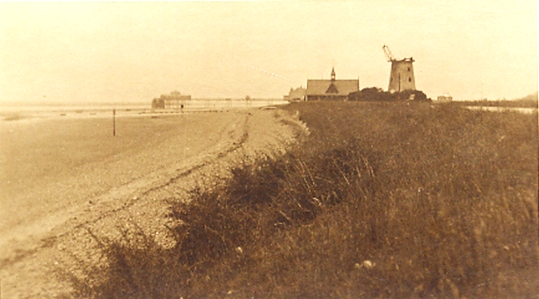
Lytham Windmill as it appeared in the
early 1920s.
1920s
RESTORATION
In 1921, probably due to the agitation by local residents,
John Talbot Clifton, Squire of Lytham, gave the mill to the people of Lytham, or
rather Lytham Council, which merged with St Annes Council in 1922. The newly
created Lytham St Annes Borough Council restored the structure, fitting it
with a new cap, sails and fantail.
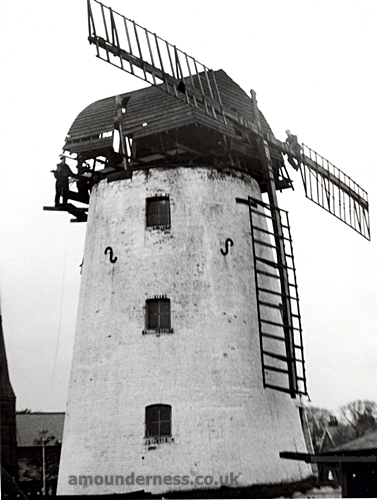
In this undated image the fantail is absent. The photo is
thought to have been taken either during the 1920s restoration, or when repairs
were made in the 1950s and 60s.
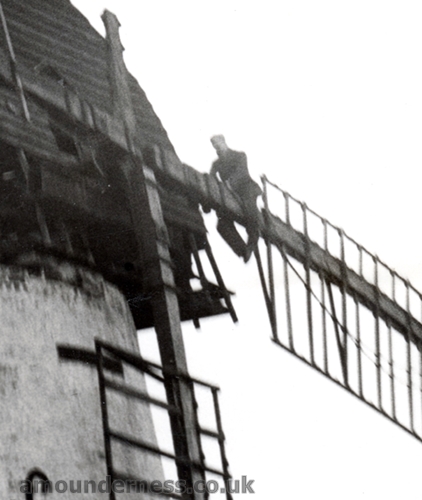
Detail from the previous photo.
The Restored
Windmill
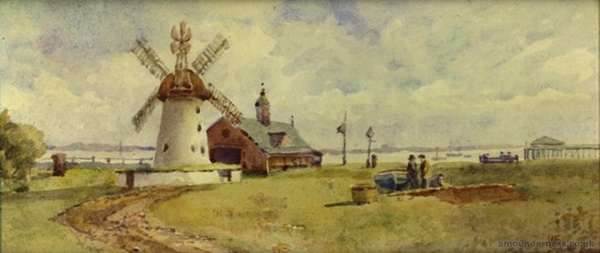
Lytham Windmill & Lifeboat House, a 1920s
watercolour by local artist, Walter Eastwood.
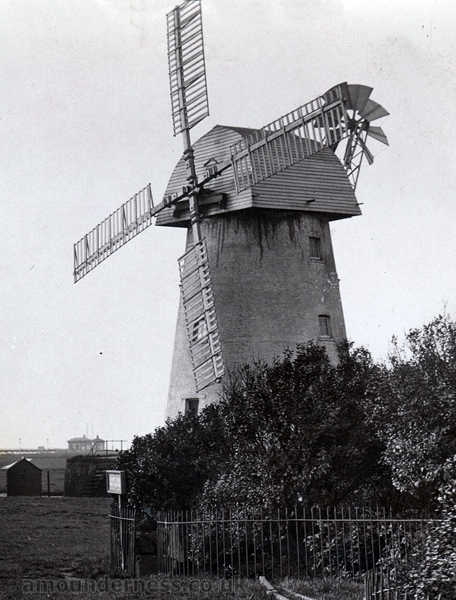
The windmill soon after the restoration was completed in 1924. A
working mill for over a century it was almost lost. It was now an ornamental
memorial to Lytham's past.
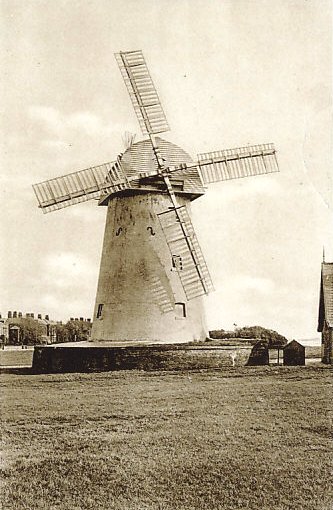
Despite the restoration, there were still structural problems.
In July 1926 "A zig-zag crack running about 8 yards down from the top of the
brickwork" suddenly appeared, "the disturbed brickwork bursting
outwards." Iron rods were used to bind the walls.
|
LYTHAM WINDMILL
CRACK DEVELOPS IN ANCIENT STRUCTURE
STEPS TO BE TAKEN TO GUARD AGAINST A COLLAPSE.
Fears are entertained for the safety of Lytham
Windmill. A crack has developed in the upper portion of the
structure, and it is understood that steps are to be taken to guard
against the possibility of a sudden collapse.
Lancashire Evening Post - Thursday
15 July 1926
|
|
|
1930s
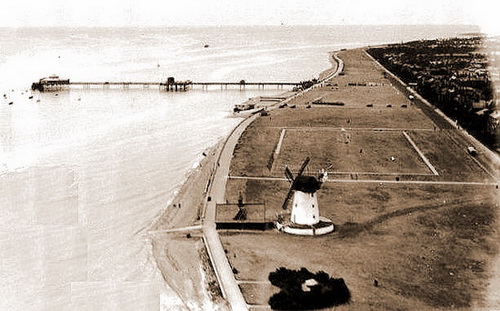
Aerial view of Lytham Windmill and Green
c1930. A fire had destroyed the Pier Pavilion in
1928.
Ye Olde Windmill Cafe
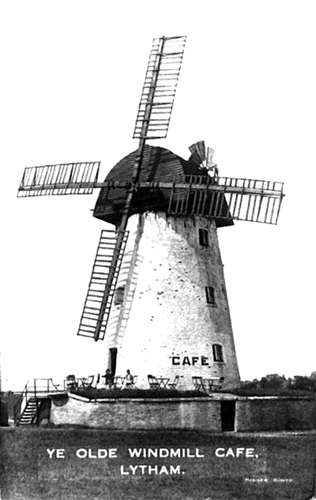
Photo of Ye Olde Windmill Cafe, Lytham, taken by Hedges
c1929.
About 1929, in an attempt to recoup some of the money spent
restoring and maintaining the structure, Lytham St Annes Borough Council
converted the windmill into a cafe. It is said that it "did not
prosper" but the situation probably wasn't helped when the signage was
opposed by Mrs Clifton; her late husband had given the windmill to the Council a
decade before.
|
OLD LYTHAM WINDMILL.
Some time ago Mrs. Clifton, of Kildalton Castle
and Lytham Hall, drew the attention of the Corporation
to a cafe sign on the old Lytham windmill, and remarked that
the Clifton Estate would not have disfigured the mill by an
advertising sign. This afternoon a recommendation came before the
Lytham St. Annes Town Council to remove the sign.
Lancashire Evening
Post - Monday 26 May 1930
|
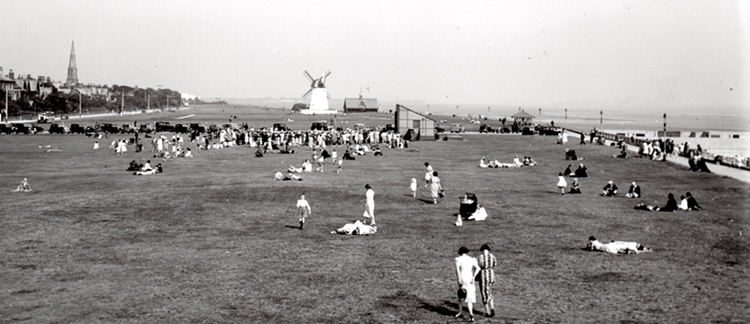
In 1932 powerful white floodlights were
installed, illuminating the windmill on summer nights. Between 1932
and 1938 it was the headquarters of the Lytham St. Annes Motor Boat Club who
transformed the lower room into a ship’s saloon. The reading room and the
lookout over the Ribble was on the second floor.
|
|
1950s
The windmill was used as a storehouse and electricity
substation between 1938 and 1954. It then became the clubhouse
for the northern section of the Ribble Cruising Club, the southern
section clubhouse being at Hesketh Bank.
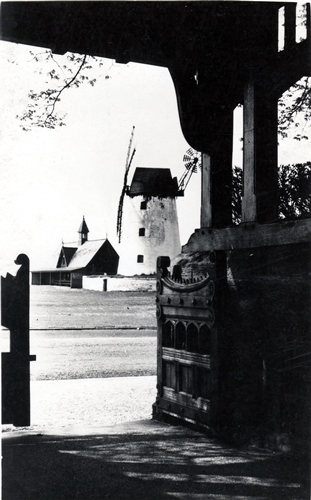
Photo by Cyril E Wilson c1950s with the windmill framed by the
lych gate of St John's Church.
|
|
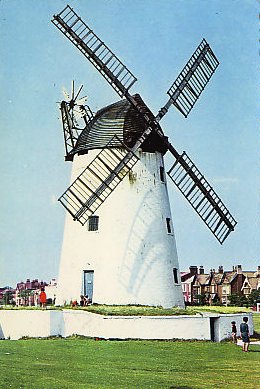
|
|
1980s
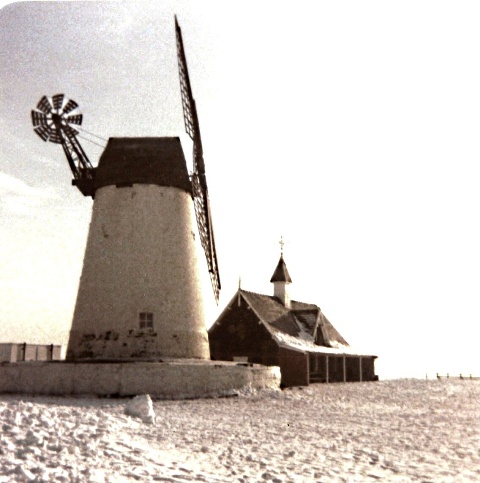
Lytham Windmill snow scene, 1981
The structure suffered severely from dry rot and in the 1980s it
took Fylde Borough Council about two years to resolve the problem. It was finally
reopened on 20 March 1989 and now houses the Lytham Windmill Museum.
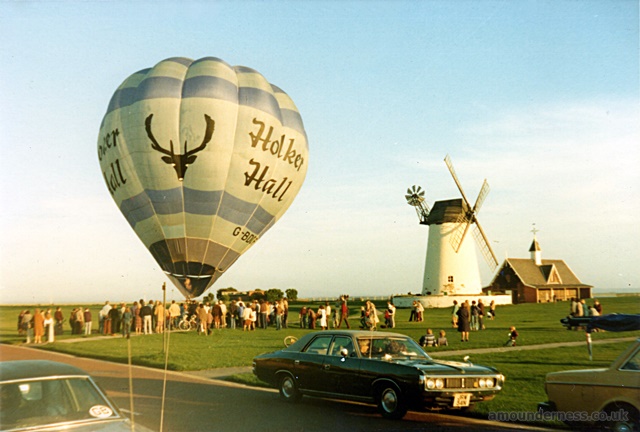
Undated photo of the Holker Hall hot air balloon on
Lytham Green, probably in the 1980s.
Lytham Windmill in the 21st
Century
During a storm on 11 November 2010 one of the sails was ripped
off the windmill by 100mph winds. This was followed by storm damage in October 2011. The repairs were carried out by Gillett & Son, Wesham.
|
|
Previous Page: Lytham Windmill in the 19th
Century
Next Page:
Lytham Windmill in the
Press
|
|
|